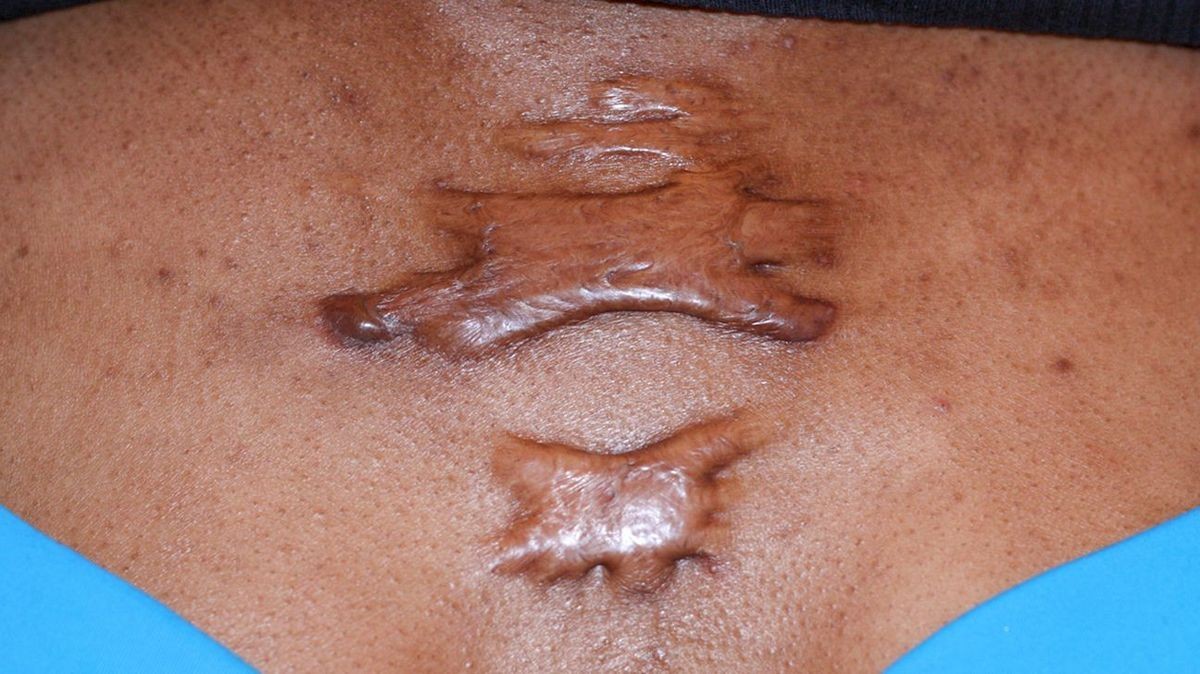
Contents
- 1 Keloid Scar
- 1.0.1 Cause of Keloids
- 1.0.2 Keloids and Piercings
- 1.0.3 Risk Factors for Keloids
- 1.0.4 Symptoms and Signs of Keloids
- 1.0.5 Common Areas for Keloid Development
- 1.0.6 Diagnosis and Treatment
- 1.0.7 Keloid, Hypertrophic Scar, and Dermatofibroma Differences
- 1.0.8 Treatments for Keloid Scars
- 1.0.9 Home Remedies and Keloid Removal
- 1.0.10 Prognosis and Prevention
Keloid Scar
Keloids are scars that don’t stop growing. A keloid is a raised scar that appears above the skin, typically smooth and pink or purple. Keloids are irregularly shaped and often increase in size. Unlike regular scars, keloids do not go away over time.
Cause of Keloids
The exact cause of keloids is not fully understood. Changes in the cellular signals that control inflammation and growth may be related to keloid formation, but these changes have not been fully characterized.
Keloids and Piercings
Keloids can develop after minor injuries from body piercing. As the popularity of body piercing has increased, so has the occurrence of keloid scarring. The reasons why some individuals are more prone to keloid formation are not fully understood, so it is impossible to predict if a first piercing will lead to keloid formation.
- Although some families have a predisposition to forming keloids, it is generally impossible to determine who will develop one.
- For example, one person may develop a keloid in one earlobe after piercing, while their other earlobe remains unaffected. It is advisable for individuals who have formed a keloid to avoid elective surgeries or cosmetic piercings.
Risk Factors for Keloids
Individuals with darkly pigmented skin have a higher risk of developing keloids, particularly those of African, Hispanic, and Asian ethnicities. Keloids are equally common in men and women but occur less frequently in children and the elderly.
Keloids can occur in individuals of all skin types, not just those with darker skin.
In some cases, a predisposition for keloid formation may run in families. A mutation in the NEDD4 gene may indicate a person’s susceptibility to keloid formation.
Symptoms and Signs of Keloids
Keloids are raised, shiny, and dome-shaped, ranging in color from pink to red. Some keloids can become large and unsightly.
In addition to cosmetic concerns, keloids can be itchy, tender, or painful to the touch.
Common Areas for Keloid Development
Keloids most commonly develop on the chest, back, shoulders, and earlobes. They rarely occur on the face, except for the jawline.
Diagnosis and Treatment
Dermatologists, plastic surgeons, and certain family physicians are typically responsible for diagnosing and treating keloids. Therapeutic radiologists may also be consulted.
Keloid, Hypertrophic Scar, and Dermatofibroma Differences
After a skin injury, scars usually appear as flat marks. Hypertrophic scars are thicker than normal scars but are confined to the wound’s margin.
- Hypertrophic scars are typically redder and may regress over time. Cortisone injections can accelerate this process.
- Dermatofibromas are small, benign, pigmented, and firm bumps on the skin. They are usually found on the legs and do not cause any additional symptoms. Dermatofibromas remain stable in size over many years and are rarely larger than half to three-quarters of an inch.
- Keloids, on the other hand, may develop after a skin injury and extend beyond the original wound. This characteristic distinguishes keloids from hypertrophic scars. While keloids commonly appear after surgery or injury, they can also be triggered by minor inflammation, such as an acne pimple on the chest. Other minor injuries, like burns or cosmetic piercings, can also lead to keloid formation.
- Keloids have a distinct microscopic appearance that sets them apart from hypertrophic scars and dermatofibromas.
IMAGES
Treatments for Keloid Scars
There are nine possible procedures available for treating keloids:
- Corticosteroid injections: These injections are safe but moderately painful. They are usually given once every four to eight weeks and help flatten keloids. However, they may cause the keloid to become redder initially. Additional laser treatment can address the increased blood vessels. It is important to note that even with treatment, the keloid will remain visibly different from the surrounding skin.
- Surgery: Surgery poses a risk as cutting a keloid can trigger the formation of a larger one. Some surgeons use steroid injections or apply compression to the wound site for months after removing the keloid to prevent regrowth. Superficial radiation treatment can also be beneficial.
- Laser treatment: Laser treatment with a pulsed-dye laser can flatten keloids and reduce redness. It is safe and not very painful, but multiple sessions may be required, which can be costly as it is often not covered by insurance.
- Silicone gel or sheeting: Wearing a silicone gel sheet on the affected area for several months can yield variable results. Some doctors claim that compression dressings made from materials other than silicone can achieve similar success.
- Pressure: Special earrings can significantly reduce the size of earlobe keloids when used appropriately.
- Cryotherapy: Freezing keloids with liquid nitrogen can flatten them, but it may also cause darkening or lightening of the treated area.
- Interferon: Injections of interferon, proteins that help fight off viruses and bacteria, have shown promise in reducing the size of keloids. Studies are underway to determine the long-term effectiveness of this treatment. Another method being researched involves applying topical imiquimod (Aldara), which stimulates the body to produce interferon.
- Fluorouracil and bleomycin: These chemotherapeutic agents, sometimes combined with steroids, have been used to treat keloids.
- Radiation: Radiation treatment for keloids has been safely and effectively used with various techniques.
Home Remedies and Keloid Removal
There are no effective home remedies for keloids, and complete removal is generally not possible. The decision to treat a keloid depends on symptoms and the affected area. If a keloid is chronically itchy or irritates the individual, treatment may be necessary. Keloids in cosmetically important areas that cause disfigurement or embarrassment should also be treated.
- Although the importance of early treatment is uncertain, larger keloids are more challenging to treat.
- Special techniques must be used immediately after a surgical procedure to prevent the formation of a new, larger keloid.
Prognosis and Prevention
Small keloids can be effectively treated using various methods, with steroid injections being a common approach. It is important to note that keloids will never completely disappear but can become less symptomatic and flatter. Treating larger keloids is more difficult.
The best way to manage keloids is to prevent their formation. Individuals who have had keloids should avoid elective or cosmetic skin surgeries and procedures such as piercing. Prevention is crucial since current treatments have limitations.
References:
– Andrews, Jonathan P., Marttala, Jaana, Macarak, Edward, Rosenbloom, Joel, Uitto, Jouni, "Keloids: The paradigm of skin fibrosis — Pathomechanismsand treatment." Matrix Biology (2016).
– Berman, Brian, Andrea Maderal, and Brian Raphael. "Keloids and Hypertrophic Scars: Pathophysiology, Classification, and Treatment." Dermatol Surg 43 (2017): S3-S18.
– He, Yongjing, et al. "From Genetics to Epigenetics: New Insights Into Keloid Scarring." Cell Proliferation 2017; e12326; DOI: 10.1111/cpr.12326: 1-8.
– Marneros, Alexander G. "A Role for the E3 Ubiquitin Ligase NEDD4 in Keloid Pathogenesis." Journal of Investigative Dermatology 2018. doi:10.1016/j.jid.2018.09.007.
– Ogawa, Rei. "Keloid and Hypertrophic Scars Are the Result of Chronic Inflammation in the Reticular Dermis." International Journal of Molecular Sciences 18 (2017): 606.
– Shockman, Soloman, Kapila V. Paghdal, and George Cohen. "Medical and Surgical Management of Keloids: A Review." Journal of Drugs in Dermatology 9.10 Oct. 2010: 1249-1257.
– Thierauf, Julia, et al. "Treatment of Ear Keloids: Algorithm for a Multimodal Therapy Regimen." Eur Arch Otorhinolaryngol DOI: 10.1007/s00405-017-4714-5.
– Trace, Anthony P., et al. "Keloids and Hypertrophic Scars: A Spectrum of Clinical Challenges." Am J Clin Dermatol Feb 19, 2016.
– Xu, Jing, et al. "Radiation Therapy in Keloids Treatment: History, Strategy, Effectiveness, and Complication." Chin Med J 130 (2017): 1715-21.
– Xu, Jing, et al. "Radiation Therapy in Keloids Treatment: History, Strategy, Effectiveness, and Complication." Chin Med J 130 (2017): 1715-21.


